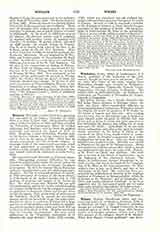

Winzet, NINIAN, Benedictine abbot and controversial writer, b. at Renfrew, Scotland, 1518; d, at Ratisbon, September 21, 1592. Educated (probably, though not certainly) at Glasgow University, he was ordained priest in 1540, and about 1551 became master of Linlithgow grammar school, and a little later provost of the collegiate church of St. Michael. When John Knox‘s “rascal multitude” was devastating the churches of Scotland in 1559, Winzet is said by Bishop Leslie to have publicly disputed with Knox at Linlithgow. After the change of religion in 1560 he was, with other ecclesiastics and teachers who refused to conform to Protestantism, ejected from his offices. On Queen Mary’s arrival in Edinburgh he went thither, at once threw himself into combat against the new doctrines, and published in 1562 his most famous work, “Certane Tractatis”—the first addressed to the queen, clergy, and nobles, the second to Knox, and the third to the provost and magistrates of Edinburgh. Their ability and erudition made an immediate impression. Winzet, who seems for a time to have been Mary’s confessor, was just bringing out his “Last Blast of the Trompet of Godis Worde”, when it was stopped by the civil authority, and the author fled from Scotland, reaching Louvain in September, 1562. Here he wrote a preface to his “Buke of Four Scoir Thre Questions” (collected from his earlier polemical writings in MS.), which was published at Antwerp in October, 1563, with a postscript addressed to Knox; and a little later his translation of the “Commonitorium” of Vincent of Lerins, dedicated to Queen Mary, also appeared at Antwerp. From 1565 to 1570 Winzet resided in Paris, prosecuting his studies at the university and apparently doing tutorial work also, as well as acting for a time as proctor for the “natio Anglicana seu Germanica”.
In 1571 he was attached by Queen Mary, then a captive in England, to the service of Bishop Leslie, her ambassador in London; but on Leslie’s committal to the Tower Winzet returned to France, and stayed for a time at Douai. From 1575 to 1577 he was in Rome, and in June, 1577, Pope Gregory XIII appointed him abbot of St. James’s Scots monastery at Ratisbon, dispensing him from the regular year’s novitiate. He received the abbatial blessing in Rome from Goldwell, the exiled Bishop of St. Asaph, at once entered on his new duties, and succeeded by his energy and zeal in repairing the shattered fortunes of St. James’s, which had suffered greatly in the upheaval of the Reformation. By his wise administration and efforts in the cause of education he won the favor and regard both of the Emperor Rudolph VI and of the Duke of Bavaria. During his fifteen years’ tenure of the abbacy he continued his literary labors, publishing his “Flagellum Sectariorum” and “Velitatio in Georgium Buchananum” in 1581, as well as other works, some of them now lost. He died at Ratisbon, and was buried in the sanctuary of St. James’s Church, where a monument with a eulogistic Latin epitaph marks his grave.
D. O. HUNTER-BLAIR

